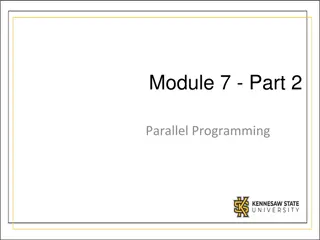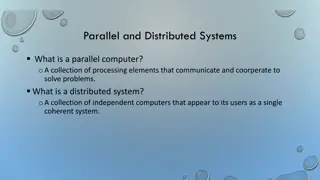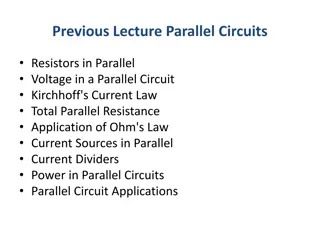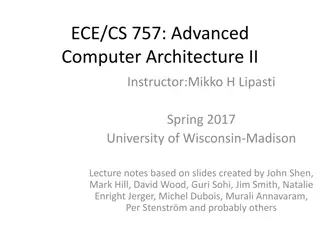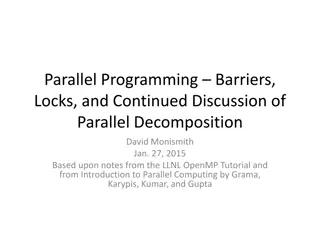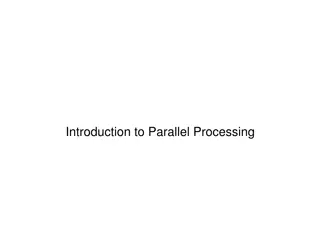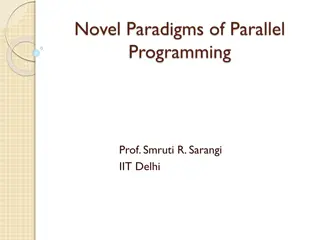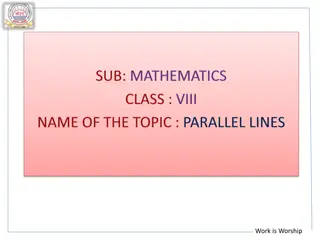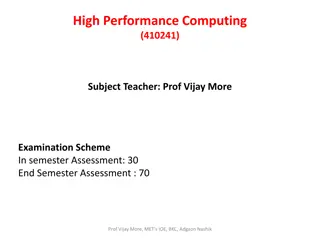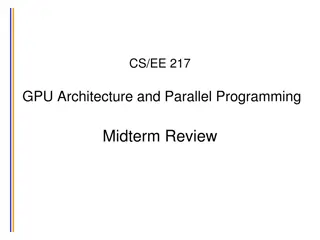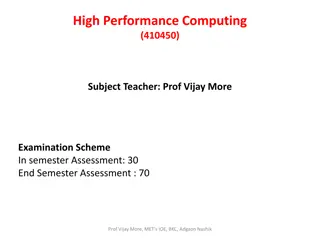
Optimizing Thread Utilization for Parallelism in Computer Science
Learn how to optimize thread utilization for parallel computing applications using techniques such as dividing workloads, managing threads efficiently, and maximizing processor usage. Explore the impact of hardware configurations on performance and the importance of load balancing in parallel programming.
Download Presentation

Please find below an Image/Link to download the presentation.
The content on the website is provided AS IS for your information and personal use only. It may not be sold, licensed, or shared on other websites without obtaining consent from the author. If you encounter any issues during the download, it is possible that the publisher has removed the file from their server.
You are allowed to download the files provided on this website for personal or commercial use, subject to the condition that they are used lawfully. All files are the property of their respective owners.
The content on the website is provided AS IS for your information and personal use only. It may not be sold, licensed, or shared on other websites without obtaining consent from the author.
E N D
Presentation Transcript
Parallelism 2 CSE 332 25Sp Lecture 20 Analysis, Amdahl s Law
Announcements Monday Monday Ex 7 (DFS, coding) due Ex 9 (reductions, gs) out Tuesday TuesdayWed Wed Friday Friday TODAY TODAY Ex 8 (Dijkstra, gs) due Ex 10,11 (parallel prog) out Ex 10 (parallel, prog) due Thursday Thursday Bring laptop! This Week Ex 9 (reductions, gs) due Next Week Optional readings (Grossman) covers next few weeks of parallelism and concurrency
ParallelSum: Take 2 int sum(int[] arr){ int len = arr.length; int ans = 0; SumThread[] ts = new SumThread[4]; for(int i=0; i<4; i++) ts[i] = new SumThread(arr, i*len/4 (i+1)*len/4); ts[i].fork() for(int i=0; i<4; i++) ts[i].join() ans += ts[i].ans; return ans; }
Optimizing: Number of Threads The last version of ParallelSum will work. I.e. it will always get the right answer And it will use 4 threads. But What if we get a new computer with 6 processors? -We ll have to rewrite our code What if the OS decides no, you only get 2 processors right now. What if our threads take wildly different amounts of time?
Optimizing: Number of Threads The counter-intuitive solution: Even more parallelism! Even more parallelism! Divide the work into more smaller pieces. If you get more processors, you take advantage of all of them. If one thread finishes super fast, throw the next thread to that processor. Load Imbalance Engineering Question: -Let s say we change our ParallelSum code so each thread adds 10 elements. -Is that a good idea? What s the running time of the code going to be?
Thread Creation If we create ?/10 threads, each summing 10 elements Creating ?/10 threads one-right-after-the-other takes (?) time. (Same with joining the threads together at the end). This is a linear time algorithm now. Can we do better?
Divide and Conquer: Parallelism What if we want a bunch of threads, but don t want to spend a bunch of time making threads? Parallelize thread creation too!
Divide and Conquer SumThread Class SumThread extends SomeThreadObject{ //constructor, fields unchanged. void run(){ if(hi-lo == 1) ans = arr[lo] else{ SumThread left = new SumThread(arr, lo, (hi+lo)/2); SumThread right = new SumThread(arr, (hi+lo)/2, hi); left.start(); right.start(); left.join(); right.join(); ans = left.ans + right.ans; } } }
Divide And Conqure SumThread int sum(int[] arr){ SumThread t = new SumThread(arr, 0, arr.length); t.run(); //this call isn t making a new thread return t.ans; }
Divide And Conquer Optimization Imagine calling our current algorithm on an array of size 4. How many threads does it make 6 It shouldn t take that many threads to add a few numbers. And every thread introduces A LOT of overhead. We ll want to cut overhead. Similar optimizations can be used for (sequential) merge and quick sort cut- -off off the parallelism when the threads cause too much
Cut-offs Are we really saving that much? Suppose we re summing an array of size 230 And we set a cut-off of size-100 -i.e. subarrays of size 100 are summed without making any new threads. What fraction of the threads have we just eliminated? 99% !!!! (for fun you should check the math)
One more optimization A small tweak to our code will eliminate half of our threads left.fork(); right.fork(); left.join(); right.join(); New version. Good amount of threads left.fork(); right.run(); left.join(); Old version. Too many threads Current thread actually executes the right hand side. Ordering of these commands is very important!
Analysis None of our optimizations will make a difference in the O() analysis But they will make a difference in practice.
ForkJoin Framework Method Method compute Use Use Thread objects override (void/V) method compute When fork is called, compute method is executed A bit like main( )---default starting point Starts a new thread executing compute method Calling otherThread.join() pauses this thread until otherThread has completed its compute. RecursiveTask<V>Class which we extend to make threads to return a result of type V.compute returns V for this object Recursive ActionClass we extend when we don t return a result ForkJoinPool Object that manages threads invoke Pool method to start first thread object. fork join
Other Engineering Decisions Getting every ounce of speedup out requires a lot of thought. Choose a good sequential threshold -Depends on the library -For ours, a few hundred to one-thousand operations in the non-parallel call is recommended. Library needs to warm up Wait for more processors? Memory Hierarchy -Won t focus on this, but it can have an effect.
ForkJoin Library---Magic Incantations import java.util.concurrent.ForkJoinPool; import java.util.concurrent.RecursiveTask; import java.util.concurrent.RecursiveAction; Two possible classes to extend RecursiveTask<E> (Returns an E object) RecrusiveAction (Doesn t return anything) First thread created by: static final ForkJoinPool POOL = new ForkJoinPool(); POOL.invoke(firstThd);
ForkJoin Library summary Start a new thread: fork() Wait for a thread to finish: join() -join() will return an object, if you extended RecursiveTask Your Thread objects need to write a compute() method Calling compute() does NOT start a new thread in the JVM.
ArraySum in ForkJoin class SumThread extends RecursiveTask<Integer>{ int lo; int hi; int[] arr; int cutoff; static final ForkJoinPool POOL = new ForkJoinPool(); public SumThread(int l, int h, int[] a, int c){ lo = l; hi = h; arr = a; cutoff = c; }
protected Integer compute(){ if(hi-lo < cutoff){ int ans=0; for(int i=lo; i<hi; i++) ans += arr[i]; return new Integer(ans); } else{ SumThread left = new SumThread(arr, lo, (hi+lo)/2); SumThread right = new SumThread(arr, (hi+lo)/2, hi); left.fork(); Integer rightAns = right.compute(); Integer leftAns = left.join(); return newInteger(leftAns + rightAns); } }
public static Integer sum(int[] arr){ SumThread thd = new SumThread(0, arr.length, arr, 500); POOL.invoke( thd ); } }//end class SumThread
Reduce It shouldn t be too hard to imagine how to modify this code to: 1. Find the maximum element in an array. 2. Determine if there is an element meeting some property. 3. Find the left-most element satisfying some property. 4. Count the number of elements meeting some property. 5. Check if elements are in sorted order. 6. [And so on ]
Reduce You did similar problems yesterday. The key is to describe: 1. How to compute the answer at the cut-off. 2. How to merge the results of two subarrays. We say parallel code like this reduces the array We re reducing the arrays to a single item Then combining with an associative e.g. sum, max, leftmost, product, count, or, and, Doesn t have to be a single number, could be an object. associative operation.
Reduce Terminology An operation like we ve seen is often called reducing the input. Don t confuse this operation with reductions from lecture 18. We ll call the parallelism-related operation a reduce. or a reduce operation (and the algorithm design thing a reduction ) This convention isn t universal (you ll find resources calling the parallel code a reduction )
Map Another common pattern in parallel code Just applies some function to each element in a collection. -No combining! PowMod from yesterday was a map Easy example: vector addition These operations are common enough that some processors do vector computations in parallel at the hardware level. -That s a major reason why GPUs are so popular for ML applications.
Maps & Reduces Maps and Reduces are workhorses of parallel programming. Google s MapReduce framework relies on these showing up frequently. -or Hadoop (the open-source version) -Usually Usually your reduces will extend RecursiveTask<E> -Usually Usually your maps will extend RecursiveAction
Analysis Big idea: let ?, the number of processors, be another variable in our big-O analysis. Let ?? be the big-O running time with ? processors. What is ?? for summing an array? We ll need to do computations in a new way.
Useful Diagram Edge from ? to ? if ? waits for ?. I.e. ?can t start until ? finishes. One node per O(1) operation Might be due to join or might be sequential code.
Useful Diagram 01: x=x+5 02: y=x+7 03: z=x+13 One node per O(1) operation What does the dependency graph look like for that snippet?
Useful Diagram 01: x=x+5 02: y=x+7 03: z=x+13 One node per O(1) operation 01 02 03
Useful Diagram For parallel code: Fork will usually split a node into two nodes (even if only one new thread is created), parent to two children (or many if many forks) Join will usually combine two nodes into one node (even if only one thread is joined), two sources to one destination (or many if many joins)
Useful Diagram Divide to create threads. One node per O(1) operation Base Case computations Join and combine to create final answer.
Useful Diagram One node per O(1) operation Question: why are there no cycles in this graph?
Analysis Big idea: let ?, the number of processors, be another variable in our big-O analysis. Let ?? be the big-O running time with ? processors. What is ?? for summing an array? ? ?+ log? ?
Definitions Work Work: ?1 it s ?(?) for summing an array. Probably (but not necessarily!!!) going to be equivalent to the running time of the code you would write if you had never heard of parallelism. Definition is running time of parallel parallel code if you had a single processor. Span Span: ? ?(log?) for summing an array ?? is running time with ?Processors, so span is you always have a processor available Longest path in graph of computation. critical path
More Definitions Speedup Speedup: for ? processors: ?1 ?? ideally: speedup will be close to ? ( perfect linear speedup ) E.g. if ?1= 100sec And ?4= 25sec, then speedup=100 25= 4 Parallelism Parallelism: ?1 ? the speedup when you have as many processors as you can use (there s a point at which another one won t actually help).
Optimal ?? We can calculate ?1,? theoretically. But we probably care about ?? for, say, ? = 4. ??can t beat (make sure you understand why): -?1/? -? So optimal running time (asymptotically) ??= ?( ?1/? ) + ? ) expected time guarantee of that O() ForkJoin Framework has expected Assuming you write your code well enough. Uses randomized scheduling.
Amdahls Law Now it s time for some bad news. In practice, your program won t just You will have a program with Some parts that parallelize well -Can turn them into a map or a reduce. Some parts that won t parallelize at all -Operations on a linked list. DATA STRUCTURES MATTER!!! -Reading a text file. -A computation where each step needs the result of the previous steps. just sum all the elements in an array.
Amdahls Law Let the work be 1 unit of time. Let ?be the portion of the code that is unparallelizable ( sequential ). ?1= ? + 1 ? = 1. At best we can get perfect linear speedup on the parallel portion ?? ? +1 ? ? So overall speedup with ? processors ?1 ?? ?+(1 ?)/? Therefore Parallelism: ?1 1 ? ? 1
Amdahls Law Suppose our program takes 100 seconds. And ? is 1/3 (i.e. 33 seconds). Amdahl s Law ?1 ?? 1 What is the running time with 3 processors 6 processors 22 processors 67 processors 1,000,000 processors (approximately). ? +1 ? ?
Amdahls Law Suppose our program takes 100 seconds. And ? is 1/3 (i.e. 33 seconds). Amdahl s Law ?1 ?? 1 What is the running time with 3 processors: 33 + 67/3 55 seconds 6 processors: 33 + 67/6 44 seconds 22 processors: 33 + 67/22 36 seconds 67 processors 33 + 67/67 34 seconds 1,000,000 processors (approximately). 33 seconds ? +1 ? ?
Amdahls Law This is BAD NEWS If 1/3 of our program can t be parallelized, we can t get a speedup better than 3. No matter how many processors we throw at our problem. And while the first few processors make a huge difference, the benefit diminishes quickly.
Amdahls Law and Moores Law In the Moore s Law days, 12 years was long enough to get 100x speedup. Suppose in 12 years, the clock speed is the same, but you have 256 processors. What portion of your program can you hope to leave unparallelized? 1 100 ?+1 ? 256 [wolframalpha says] ? 0.0061.
Amdahls Law and Moores Law Moore s Law was a business decision - How much effort/money/employees are dedicated to improving processors so computers got faster. Amdahl s Law is a theorem - You can prove it formally.
Amdahls Law: Moving Forward Unparallelized code becomes a bottleneck quickly. What do we do? Design smarter algorithms! Consider the following problem: Given an array of numbers, return an array with the running sum 3 3 7 7 6 6 2 2 4 4 3 3 10 10 16 16 18 18 22 22
More clever algorithms Doesn t look parallelizable But it is! Think about how you might do this (it s NOT obvious) We ll go through it on Monday!

